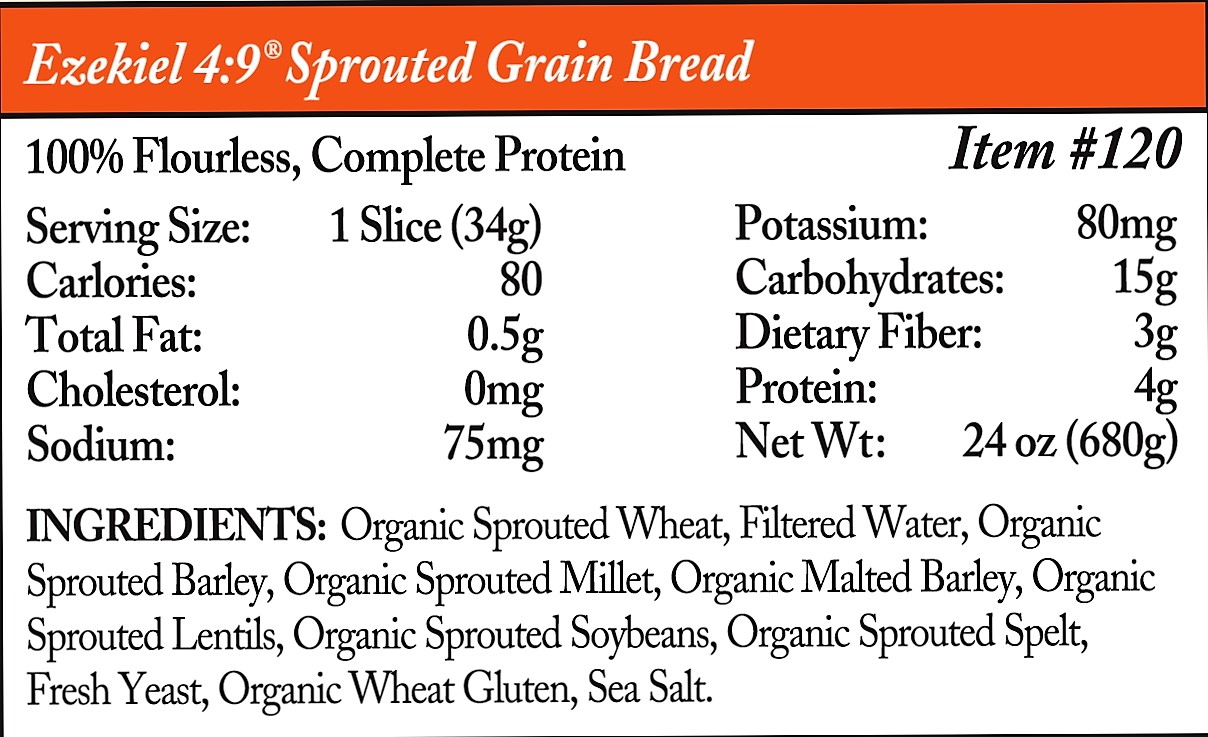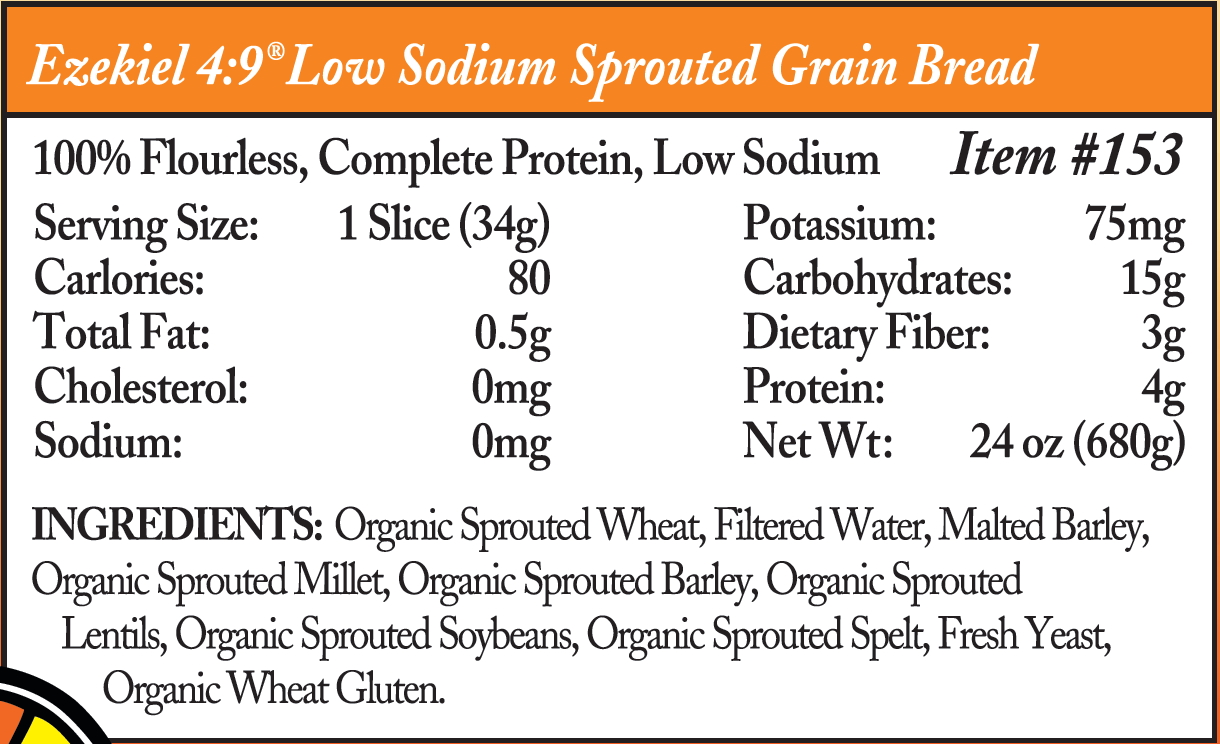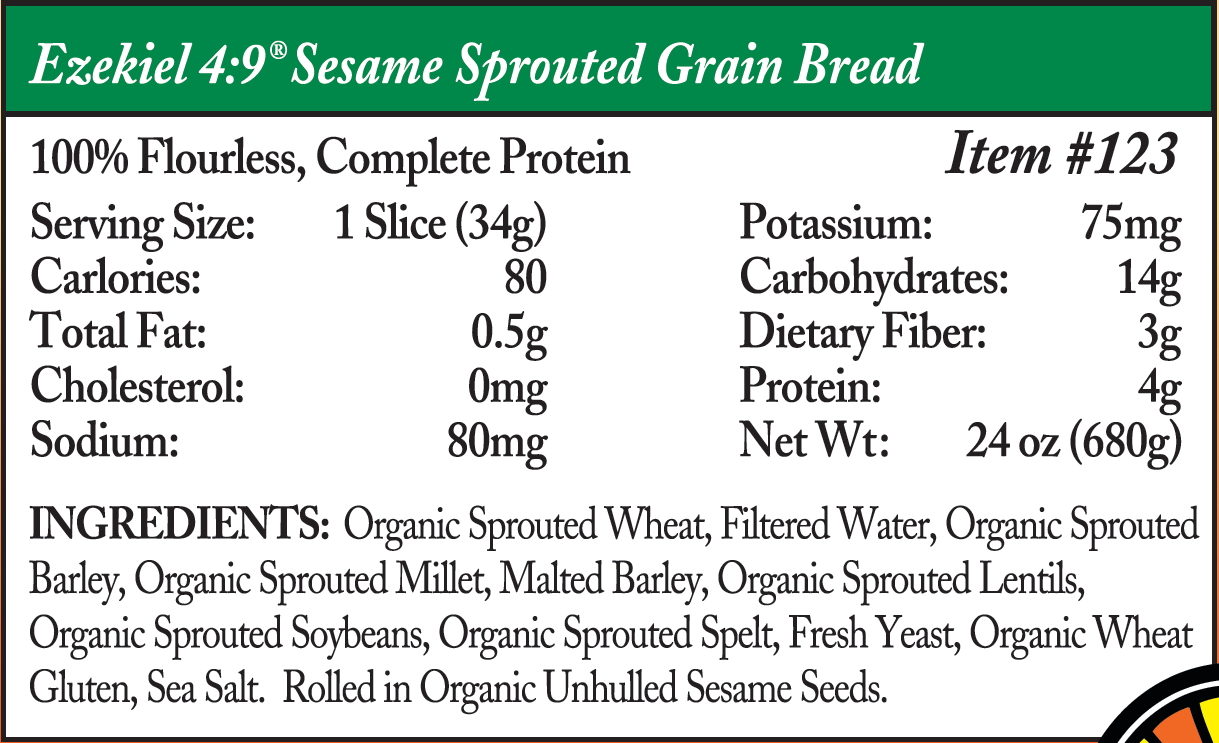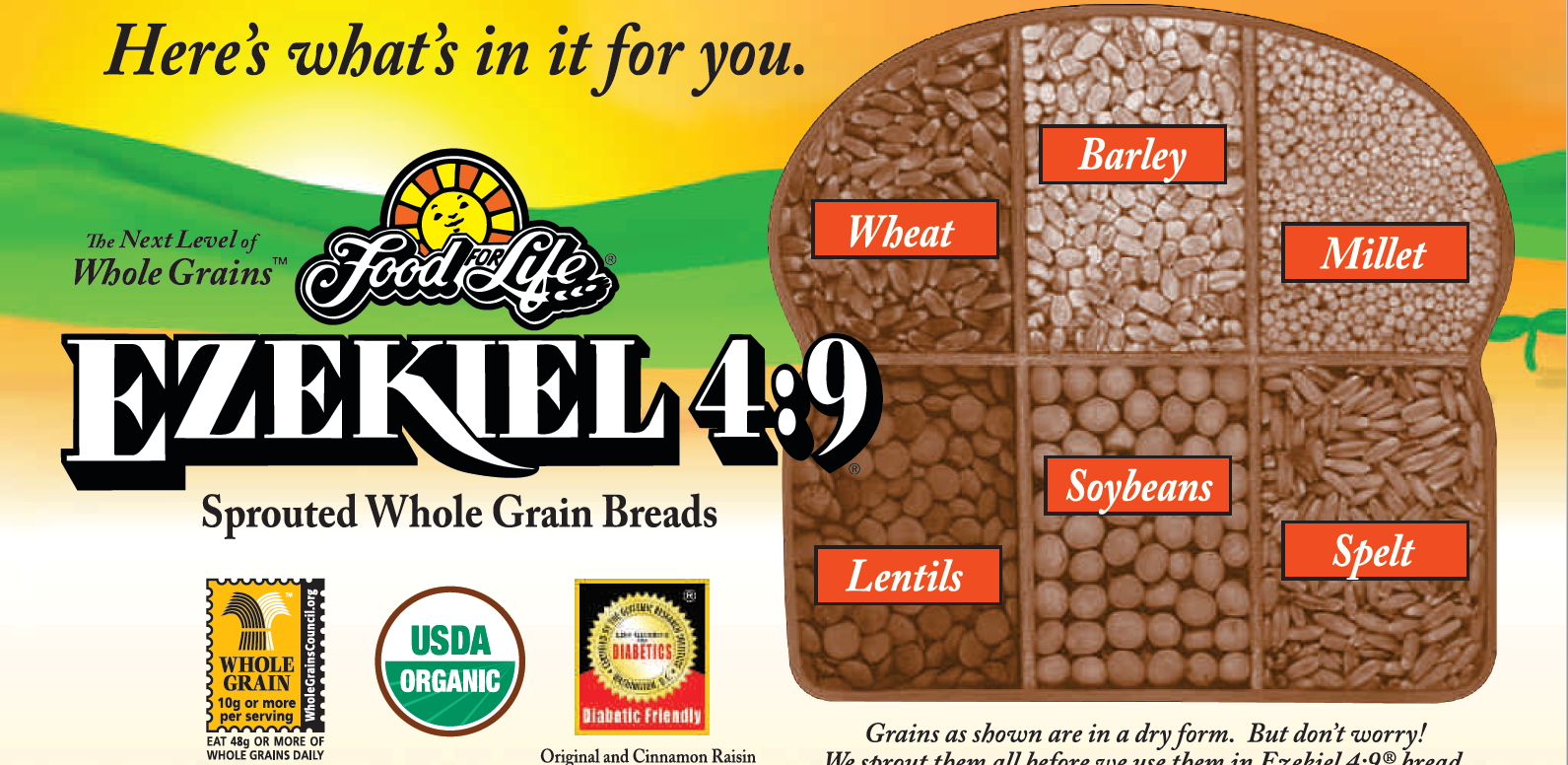
Contents
- What is Ezekiel Bread
- What is Sprouting ?
- What are Sprouted Grains ?
- Is ezekiel bread gluten free ?
- Ezekiel Bread Nutrition and Ezekiel Bread Ingredients
- Figure 2. Ezekiel Bread – Sprouted Grain Ingredients and Nutritional Value (Carbs, Calories, Protein and Dietary Fiber)
- Figure 3. Ezekiel Bread – Low Sodium Sprouted Grain Ingredients and Nutritional Value
- Figure 4. Ezekiel Bread – Sesame Sprouted Grain Ingredients and Nutritional Value
- Figure 5. Ezekiel Bread – Cinnamon Raisin Sprouted Grain Ingredients and Nutritional Value
- Table 2. Ezekiel Bread – Sprouted Grain Bread Nutritional Value from the United States Department of Agriculture, USDA Food Composition Databases.
- Table 3. Basic Whole Grain Bread Nutritional Value from the United States Department of Agriculture, USDA Food Composition Databases.
- Health Benefits of Sprouted Whole Grains
- Is Ezekiel Bread Healthy
- Is Ezekiel bread good for you ?
What is Ezekiel Bread
Ezekiel bread is a type of organic bread made with these ingredients:
- Organic Sprouted Wheat
- Organic Sprouted Barley
- Organic Sprouted Millet
- Organic Malted Barley
- Organic Sprouted Lentils
- Organic Sprouted Soybeans
- Organic Sprouted Spelt
- Fresh Yeast
- Organic Wheat Gluten
- Sea Salt
- Filtered water
The standard Ezekiel bread are made with six organic grains (wheat, barley, spelt, millet) and legumes (lentils, soybeans) and according to the Ezekiel bread manufacturer, Food for Life Baking Company Inc., their don’t use any genetically modified organisms (GMOs) 1. And instead of sugar, Ezekiel bread uses malted barley, a natural sweetener produced from sprouted barley, which is basically a carbohydrate comprised mostly of complex carbohydrates 1.
The original Ezekiel bread was made by Max Torres in 1964 and now the Ezekiel bread company also makes English muffins, tortillas, cereals, tortillas, pocket breads, buns, waffles and pasta 2.
What is Sprouting ?
Sprouting or germination is a common problem for grain when weather is moist during harvest or the environment is humid during storage 3. When kernels absorb moisture from their surroundings to a sufficient level, the embryo and endosperm are hydrated. Hydration switches on the metabolism of the embryo, which sends hormonal signals to the aleurone layer, triggering the synthesis of enzymes responsible for digesting components of the starchy endosperm. Sprouting promotes the development of cytolytic, proteolytic, and amylolytic enzymes that are not active in dry kernels 4, 5 and could cause significant changes in kernel composition and physical properties 4. Sprouting not only causes compositional changes in the grain but also initiates a series of biochemical and physiological changes. Intrinsic enzymes such as amylases, proteases, lipases, fiber-degrading enzymes, and phytases are activated; this disrupts protein bodies and degrades proteins, carbohydrates, and lipids to simpler molecules, which increases digestibility of proteins and carbohydrates in the kernel and makes nutrients available and accessible for enzymes 6, 7. Research on baby food showed that sprouting can activate enzymes, decrease the level of antinutritional factors (tannins, phytic acid), and increase digestibility of macronutrients, bioavailability of minerals, and content of essential amino acids 8, 6. In a 1989 meta-analysis of existing studies, JK Chavan and SS Kadam found evidence that sprouting of grains for a limited period causes increased activities of hydrolytic enzymes, improvement in the contents of certain essential amino acids, total sugars and B-group vitamins, and a decrease in dry matter, starch, and antinutrients. The digestibilities of storage proteins and starch are improved due to their partial hydrolysis during sprouting. The digestibilities of storage proteins and starch are improved due to their partial hydrolysis during sprouting. The magnitude of the nutritional improvement is, however, influenced by the type of cereal, seed quality, sprouting conditions, and it is not large enough to account for in feeding experiments with higher animals 9.
- Controlled Sprouting for Maximum Benefits
While a little sprouting appears to be good for us, there’s a sweet spot. Just the right amount of time, temperature, and moisture are necessary to start the germination process. Too much moisture, and the grain drowns, with the seed splitting open not from the force of an emerging, vibrant seedling but instead, simply from waterlogged swelling. Or, the sprout may begin to emerge but then, if the moisture source is not removed, it can begin to ferment or even to rot. Time is important too: if a healthy sprout continues to grow indefinitely, it becomes a new grass stalk, losing its digestibility, since humans can’t properly digest grasses.
- Dry or Wet Sprouting ?
Companies making sprouted grain products currently use two different approaches – dry and wet – once the grains are sprouted.
- The Dry Approach. Some companies sprout the grain then dry it , to lock in this ideal stage. At this point, the sprouted grain can be stored until it’s cooked as a side dish, or it can be milled into sprouted grain flour, which is in turn used to make a wide variety of products.
- The Wet Approach. Alternately, other companies mash the wet, sprouted grains into a thick purée which is used to make breads, tortillas, muffins and other products. These products are often described as “flourless” and are frequently sold frozen.
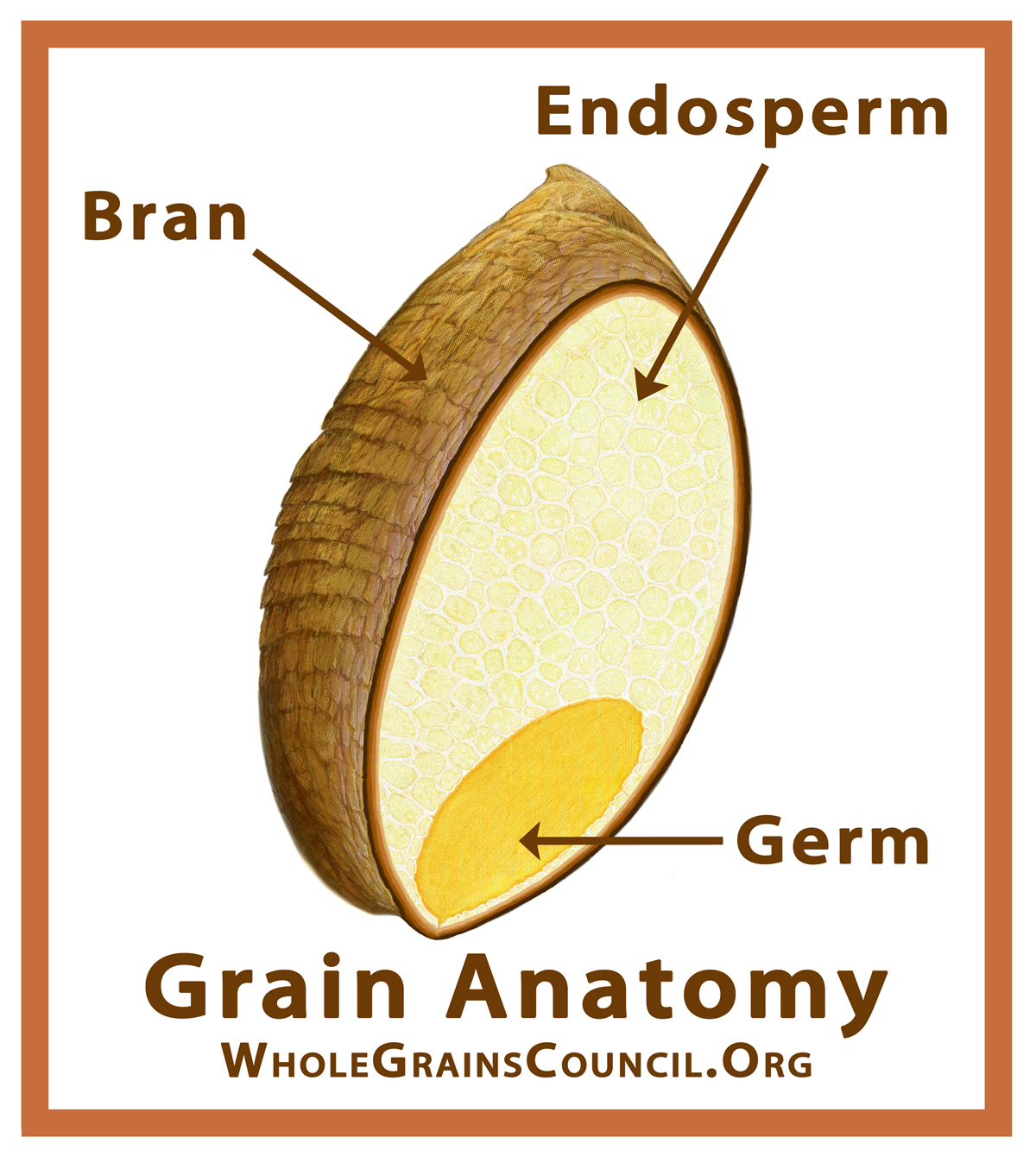
What are Sprouted Grains ?
Grains are the seeds of certain plants, largely cereal grasses. Like all seeds, grain kernels are a marvel of nature, containing the potential of a whole new plant, patiently waiting its turn in the sun.
All three edible parts of the whole grain – the germ, endosperm, and bran – are crucial to creating the new plant. The germ is the plant embryo, which, when it grows, will feed on the starchy endosperm. The bran layers provide some additional nutrients and — along with the inedible husk found on many grains – help protect the grain seed until it’s ready to start the growth cycle.
Until then, the seed counts on certain built-in growth inhibitors to keep it from germinating until temperature and moisture conditions are just right. Then, once sprouting starts, enzyme activity wipes out these growth inhibitors and transforms the long-term-storage starch of the endosperm to simpler molecules that are easily digested by the growing plant embryo.
Controlled sprouting of grains might lead to the development of specific enzymatic pattern (amylases, proteases, cellulases) that may improve cereals micronutrients bioavailability, color, taste and flavor. The inclusion of sprouted wheat has been shown to enhance flavor, increase digestibility and the nutrient content in bread formulations 10. Due to the phytochemical presence and bioavailability of vitamins and minerals, sprouted wheat can provide added nutritional value to baked goods. Dough processing challenges and quality issues exist with the addition of sprouted flour. Currently, little research exists showing how different concentrations of sprouted grains can affect the physical attributes and shelf-stability of pan bread. This study to evaluate the concentration effect of sprouted whole grain flour on the physical and textural qualities of a sponge-and-dough processed whole wheat pan bread. Texture analysis determined that the addition of 30% (110 g) and 50% (87 g) sprouted flour created a softer crumb than the control (120 g). In summary, moderate additions of whole grain sprouted flour to pan bread can lengthen shelf-life and increase loaf volume thereby improving consumer satisfaction 10.
The use of partially sprouted wheat as alternative to conventional flour improvers (e.g. xylanase, malt) has not been thoroughly investigated. In order to investigate the effects of sprouted wheat as flour improver, scientists at the ACCC (formerly known as American Association of Cereal Chemists) added Xylanase and malt to the control flour at 0.5% level, as conventionally used in bakeries, whereas sprouted wheat flour was used up to 2%. Adding xylanase, malt or sprouted wheat to control flour significantly decreased dough stiffness, though best performances were observed in the presence of 1.5% sprouted wheat 11. Unlikely the mixtures containing xylanase or malt, the sprouted wheat blend showed gluten aggregation strength similar to that of the control, suggesting no worsening of the protein network characteristics. As for the leavening properties, dough development was increased from 52.8 mm to 70.4 mm, thanks to the enrichment with sprouted flour. In addition, presence of sprouted wheat improved the amount of gas production during leavening, resulting in dough with increased volume. As for the pasting properties, in the presence of sprouted wheat lower setback values were observed, thus indicating a lower starch retrogradation tendency, as demonstrated by analyzing the crumb texture after three days of storage. In conclusion, addition of 1.5% sprouted wheat may represent a valid alternative to xylanase or malt for improving the rheological properties and bread making performance of stiff flours 11.
According to the Whole Grains Council – there is at this time no regulated definition of “sprouted grain”12.
The AACC International and one of the world’s leading authorities on grains, defines sprouted grains as “malted or sprouted grains containing all of the original bran, germ, and endosperm shall be considered whole grains as long as sprout growth does not exceed kernel length and nutrient values have not diminished. These grains should be labeled as malted or sprouted whole grain” 13. And the AACC Internation definition has subsequently been endorsed by USDA.
Figure 1. Sprouted Grain
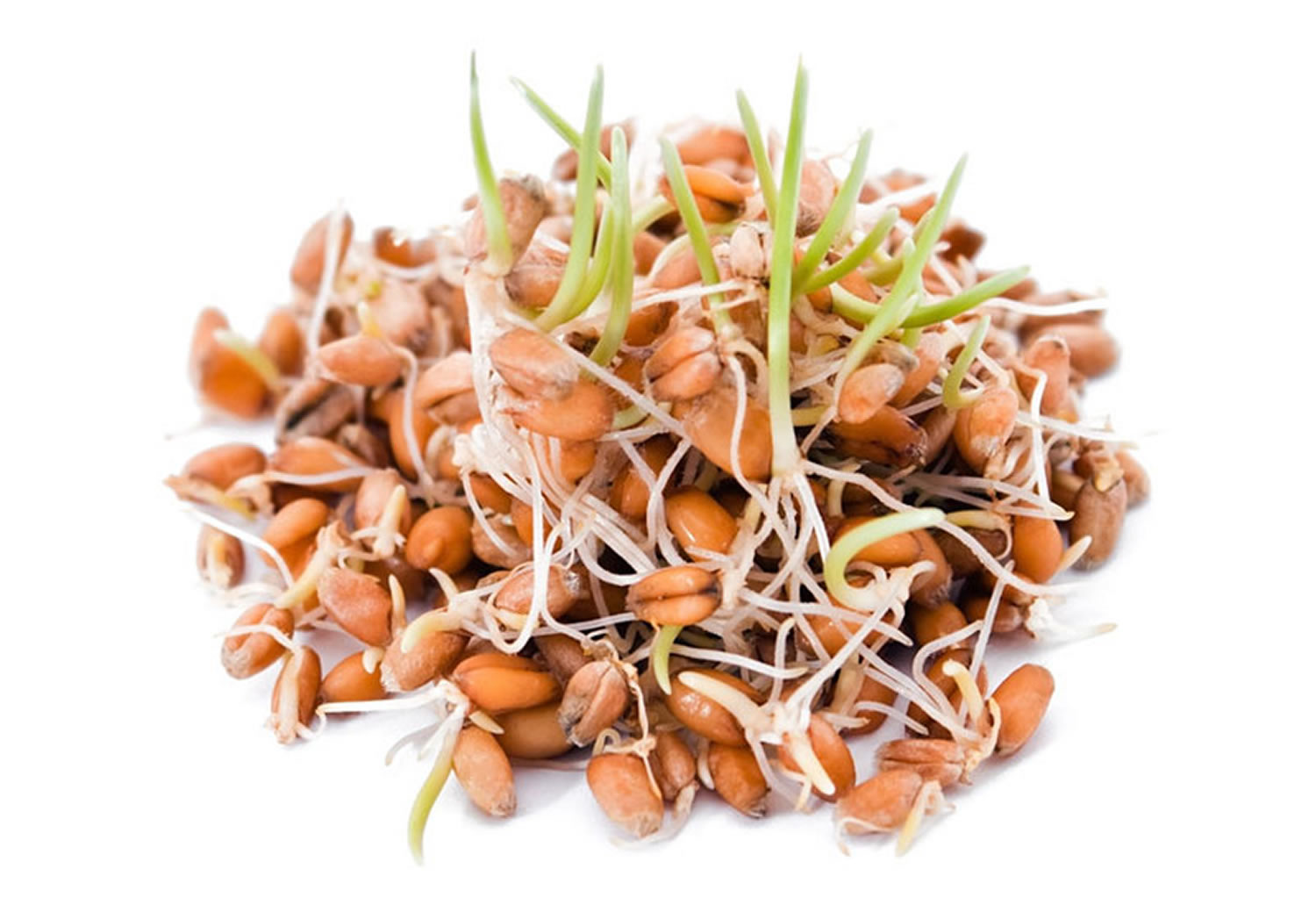
Is ezekiel bread gluten free ?
No. Ezekiel bread is made from wheat and wheat contains gluten.
Gluten is a protein naturally found in some grains including wheat, barley, rye, and spelt. It acts like a binder, holding food together and adding a “stretchy” quality—think of a pizza maker tossing and stretching out a ball of dough. Without gluten, the dough would rip easily 14.
Other grains that contain gluten are wheat berries, durum, emmer, semolina, farina, farro, graham, khorasan wheat, einkorn, and triticale (a blend of wheat and rye). Oats—though naturally gluten free—often contain gluten from cross-contamination, as they are processed in the same facilities as the grains listed above. Gluten is also sold as wheat gluten, or seitan, a popular vegan high-protein food. Less obvious sources of gluten include monosodium glutamate (MSG), soy sauce, lecithin, modified food starch, and occasionally medications and vitamins (from cross-contamination or the use of wheat starch as fillers or in the coatings).
Ezekiel Bread Nutrition and Ezekiel Bread Ingredients
The 2015-2020 Dietary Guidelines for Americans recommends eating 6 ounces of grain foods daily (based on a 2000-calorie diet) and getting at least half or 3 ounces of that grain intake from 100% whole grains 15.
An easy way to tell if a food product is high in 100% whole grains is to make sure it is listed first or second in the ingredient list. Or better yet, choose unprocessed whole grains:
Table 1. Whole Grains
| Amaranth | Kamut | Spelt |
| Barley | Millet | Teff |
| Brown Rice | Quinoa | Triticale |
| Buckwheat | Rye | Wheat Berries |
| Bulgur | Oats | Wild Rice |
| Corn | Sorghum |
Be careful when choosing foods labeled as whole grains: “Whole grain” doesn’t always mean healthy.
Figure 2. Ezekiel Bread – Sprouted Grain Ingredients and Nutritional Value (Carbs, Calories, Protein and Dietary Fiber)
[Source: Food for Life Baking Company Inc. Ezekiel Bread. 16]Figure 3. Ezekiel Bread – Low Sodium Sprouted Grain Ingredients and Nutritional Value
[Source: Food for Life Baking Company Inc. Ezekiel Bread. 16]Figure 4. Ezekiel Bread – Sesame Sprouted Grain Ingredients and Nutritional Value
[Source: Food for Life Baking Company Inc. Ezekiel Bread. 16]Figure 5. Ezekiel Bread – Cinnamon Raisin Sprouted Grain Ingredients and Nutritional Value
[Source: Food for Life Baking Company Inc. Ezekiel Bread. 16]Table 2. Ezekiel Bread – Sprouted Grain Bread Nutritional Value from the United States Department of Agriculture, USDA Food Composition Databases.
Nutrient | Unit | 34 g | Value per 100 g | ||||||||||||||||
|---|---|---|---|---|---|---|---|---|---|---|---|---|---|---|---|---|---|---|---|
| Approximates | |||||||||||||||||||
| Energy | kcal | 80 | 235 | ||||||||||||||||
| Protein | g | 4.00 | 11.76 | ||||||||||||||||
| Total lipid (fat) | g | 0.50 | 1.47 | ||||||||||||||||
| Carbohydrate, by difference | g | 15.00 | 44.12 | ||||||||||||||||
| Fiber, total dietary | g | 3.0 | 8.8 | ||||||||||||||||
| Sugars, total | g | 0.00 | 0.00 | ||||||||||||||||
| Minerals | |||||||||||||||||||
| Calcium, Ca | mg | 0 | 0 | ||||||||||||||||
| Iron, Fe | mg | 0.72 | 2.12 | ||||||||||||||||
| Magnesium, Mg | mg | 24 | 71 | ||||||||||||||||
| Phosphorus, P | mg | 80 | 235 | ||||||||||||||||
| Potassium, K | mg | 80 | 235 | ||||||||||||||||
| Sodium, Na | mg | 75 | 221 | ||||||||||||||||
| Zinc, Zn | mg | 0.60 | 1.76 | ||||||||||||||||
| Vitamins | |||||||||||||||||||
| Vitamin C, total ascorbic acid | mg | 0.0 | 0.0 | ||||||||||||||||
| Thiamin | mg | 0.340 | 1.000 | ||||||||||||||||
| Riboflavin | mg | 0.034 | 0.100 | ||||||||||||||||
| Niacin | mg | 1.764 | 5.188 | ||||||||||||||||
| Vitamin B-6 | mg | 0.118 | 0.346 | ||||||||||||||||
| Vitamin A, IU | IU | 0 | 0 | ||||||||||||||||
| Lipids | |||||||||||||||||||
| Fatty acids, total saturated | g | 0.201 | 0.590 | ||||||||||||||||
| Fatty acids, total trans | g | 0.000 | 0.000 | ||||||||||||||||
| Cholesterol | mg | 0 | 0 | ||||||||||||||||
Table 3. Basic Whole Grain Bread Nutritional Value from the United States Department of Agriculture, USDA Food Composition Databases.
Nutrient | Unit | 43 g | Value per 100 g | ||||||||||||||||
|---|---|---|---|---|---|---|---|---|---|---|---|---|---|---|---|---|---|---|---|
| Approximates | |||||||||||||||||||
| Energy | kcal | 110 | 256 | ||||||||||||||||
| Protein | g | 5.00 | 11.63 | ||||||||||||||||
| Total lipid (fat) | g | 2.00 | 4.65 | ||||||||||||||||
| Carbohydrate, by difference | g | 19.00 | 44.19 | ||||||||||||||||
| Fiber, total dietary | g | 3.0 | 7.0 | ||||||||||||||||
| Sugars, total | g | 2.00 | 4.65 | ||||||||||||||||
| Minerals | |||||||||||||||||||
| Calcium, Ca | mg | 40 | 93 | ||||||||||||||||
| Iron, Fe | mg | 1.08 | 2.51 | ||||||||||||||||
| Sodium, Na | mg | 160 | 372 | ||||||||||||||||
| Vitamins | |||||||||||||||||||
| Vitamin C, total ascorbic acid | mg | 0.0 | 0.0 | ||||||||||||||||
| Thiamin | mg | 0.000 | 0.000 | ||||||||||||||||
| Riboflavin | mg | 0.034 | 0.079 | ||||||||||||||||
| Niacin | mg | 1.396 | 3.247 | ||||||||||||||||
| Vitamin A, IU | IU | 0 | 0 | ||||||||||||||||
| Lipids | |||||||||||||||||||
| Fatty acids, total saturated | g | 0.000 | 0.000 | ||||||||||||||||
| Fatty acids, total monounsaturated | g | 0.000 | 0.000 | ||||||||||||||||
| Fatty acids, total polyunsaturated | g | 1.002 | 2.330 | ||||||||||||||||
| Fatty acids, total trans | g | 0.000 | 0.000 | ||||||||||||||||
| Cholesterol | mg | 0 | 0 | ||||||||||||||||
Health Benefits of Sprouted Whole Grains
Sprouting grains increases many of the grains’ key nutrients, including B vitamins, vitamin C, folate, fiber, and essential amino acids often lacking in grains, such as lysine. Sprouted grains may also be less allergenic to those with grain protein sensitivities 18.
In a 1989 meta-analysis of existing studies, JK Chavan and SS Kadam found evidence that sprouting of grains for a limited period causes increased activities of hydrolytic enzymes, improvement in the contents of certain essential amino acids, total sugars and B-group vitamins, and a decrease in dry matter, starch, and antinutrients. The digestibilities of storage proteins and starch are improved due to their partial hydrolysis during sprouting. The digestibilities of storage proteins and starch are improved due to their partial hydrolysis during sprouting. The magnitude of the nutritional improvement is, however, influenced by the type of cereal, seed quality, sprouting conditions, and it is not large enough to account for in feeding experiments with higher animals 9.
The pace of research is quickening, with studies documenting a wide range of health benefits for different sprouted grains. Here are just a few:
- Sprouted brown rice fights diabetes.
- Sprouted buckwheat protects against fatty liver disease.
- Cardiovascular risk reduced by sprouted brown rice.
- Sprouted brown rice decreases depression and fatigue in nursing mothers.
- Decreased blood pressure linked to sprouted barley.
- Sprouting Increases Antioxidant Activity in Millet
Research shows that millet, a nutritious staple crop in many developing countries, can be made even more nutritious when the grains are sprouted. In a study in India, scientists measured the phenolic composition, antioxidant activity, and inhibitory properties against alpha-glucosidase and alpha-amylase (a mechanism that helps prevent spikes in blood sugar) of raw millet, germinated (sprouted) millet, and microwaved and steamed millet. Compositional analysis of phenolics by HPLC revealed that vanillic and ferulic acids were the principal phenolic acids and kaempferol was the predominant flavonoid found in raw millets. Different processing treatments brought about relevant changes in the composition and content of certain phenolic acids and flavonoids in processed millets. The researchers found that germinated millets showed highest phenolic content as well as superior antioxidant and enzyme inhibitory activities. These results suggest that sprouted millet grains are potential source of phenolic antioxidants and also great sources of strong natural inhibitors for α-amylase and α-glucosidase 19.
- Sprouted Wheat Higher in Nutrients
We all know that whole grains are more nutritious than their refined counterparts (see our other post What is Whole Grain ?). But increasingly, research is showing that sprouted whole grains can offer even greater benefits. In a recent study, Vietnamese researchers sprouted wheat for 48 hours, and found it was higher in dietary fiber, free amino acids and antioxidant activity than unsprouted wheat. Germinated waxy wheat had a better nutritional composition, such as higher dietary fibre, free amino acid and total phenolic compound contents, than ungerminated waxy wheat. Therefore germinated waxy wheat should be used to improve the nutritional quality of cereal-based products 20.
- Sprouting (Malting) Millet Makes Some Minerals More Bioavailable
In India and some other countries, sprouted (malted) grains are commonly used as weaning foods for infants and as easily-digested foods for the elderly and infirm. A study at the Central Food Technological Research Institute in Mysore, India, measured the changes caused by malting finger millet, wheat and barley 21. Malted grains are extensively used in weaning infants and geriatric foods. Malting generally improves the nutrient content and digestibility of foods. The present investigation examined the influence of malting of finger millet, wheat, and barley on the bioaccessibility of iron, zinc, calcium, copper, and manganese. Malting increased the bioaccessibility of iron by >3-fold from the two varieties of finger millet and by >2-fold from wheat, whereas such a beneficial influence was not seen in barley. The bioaccessibility of zinc from wheat and barley increased to an extent of 234 and 100%, respectively, as a result of malting. However, malting reduced the bioaccessibility of zinc from finger millet. Malting marginally increased the bioaccessibility of calcium from white finger millet and wheat. Whereas malting did not exert any influence on bioaccessibility of copper from finger millet and wheat, it significantly decreased (75%) the same from barley. Malting did increase the bioaccessibility of manganese from brown finger millet (17%) and wheat (42%). Thus, malting could be an appropriate food-based strategy to derive iron and other minerals maximally from food grains 21.
- Nutrient Changes Noted in Sprouted Wheat
German researchers sprouted wheat kernels for up to 168 hours (1 week) at 15, 20, 25, or 30 °C, analyzing them at different stages to learn the effects of sprouting on different nutrient levels. While different times and temperatures produced different effects, overall the sprouting process decreased gluten proteins substantially, while increasing folate. A maximum 3.6-fold concentration was obtained after 102 hours of sprouting at 20 °C and 25 °C including 5-methyltetrafolate as the major vitamer. The concentration of dietary fiber remained constant or decreased during the first 96 hours of germination. Prolonged sprouting times of up to 168 hours led to a substantial increase of total dietary fiber and to a strong increase of the soluble dietary fiber by a factor of 3, whereas the insoluble fiber decreased by 50% 22.
- Sprouted Millet is Higher in Key Nutrients
Researchers in India allowed proso millet (a minor millet) to germinate for 1-7 days, then analysed the changes in its composition of protein fractions, free amino acids, lysine, tryptophan, methionine, non-protein nitrogen, starch, and sugars 23. They found that overnight soaking and germination up to 7 days significantly increased the free amino acids and total sugars while the content of dry weight and starch decreased. Increases in albumin and globulin and large decreases in prolamin accompanied sprouting. The percent protein in germinated grains was higher than in the initial grain as a result of dry matter loss during germination. Further, there was an increase in lysine, tryptophan and non-protein nitrogen contents during germination. No change was noticed in methionine 23.
- Digestibility Changes in Sprouted Barley
In an experiment at the University of Alberta, barley and canola seeds were sprouted over a 5 day period, in laboratory conditions under room temperature (22 degrees C) and room lighting. Following initial hydration, seeds were kept moist by wetting the germination trays at 9 a.m., 1 p.m. and 6 p.m. daily. A parallel germination experiment using 200 g quantities of seeds in petri dishes was conducted. Starting from the second day of germination, and every day, dishes of germinating seeds were removed, oven-dried, weighed and milled for proximate and chemical analysis. Seeds from the main germination experiment were fed in a digestibility trial to Wistar rats. Results indicated that sprouting was associated with depletion of many nutrients in both barley and canola, the major losses being in respect of dry matter, gross energy and triglycerides 24. In barley (but not in canola) sprouting was associated with significant increases in crude fiber and diglyceride content. In canola, there were significant losses in lipid content and increases in phytosterol and phospholipid content. Digestibility data showed an enhancement in digestibility of nutrients in barley but not in canola, implying that sprouting improved nutritional quality of barley but not canola 24.
Is Ezekiel Bread Healthy
According to the AACC (formerly known as American Association of Cereal Chemists) International, sprouted grains can be considered as an improved version of whole grains with better taste and health-enhancing properties. However, nutritional and therapeutic properties of sprouted grains still remain unclear, particularly when assessing optimum seed-modification and consensus on method-development to make such assessment. Discussions on sprouted grains in terms of nutrient bioavailability, safety and regulatory, and their role in human health and disease prevention together with the associated transparency have never been needed more than in today’s competitive and health-driven food market and health-conscious consumers 25.
Is Ezekiel bread good for you ?
Ezekiel bread is just a bread like any whole grain breads that are out there. There is no scientific evidence showing that eating Ezekiel bread is good for you and there is nothing good from eating Ezekiel bread than eating your basic wholegrain bread due to similar nutritional contents (calories, carbs, fiber) between the bread. Furthermore, most breads sold today (white plain bread, whole grain bread) have also been fortified with vitamins like Thiamin and Folate. Lastly if you have Celiac disease or suffer from wheat or gluten sensitivity, you must avoid eating anything that contain gluten including Ezekiel bread.
- The healthiest sources of carbohydrates—unprocessed or minimally processed whole grains, vegetables, fruits and beans—promote good health by delivering vitamins, minerals, fiber, and a host of important phytonutrients.
- Unhealthier sources of carbohydrates include white bread, pastries, sodas, and other highly processed or refined foods. These items contain easily digested carbohydrates that may contribute to weight gain, interfere with weight loss, and promote diabetes and heart disease.
A growing body of research shows that choosing whole grains and other less-processed, higher-quality sources of carbohydrates, and cutting back on refined grains, improves health in many ways. The 2015-2020 Dietary Guidelines for Americans recommends eating 6 ounces of grain foods daily (based on a 2000-calorie diet) and getting at least half or 3 ounces of that grain intake from 100% whole grains 15. Consumers should steer towards whole grain foods that are high in fiber and that have few ingredients in addition to whole grain. Moreover, eating whole grains in their whole forms—such as brown rice, barley, oats, corn, and rye—are healthy choices because they pack in the nutritional benefits of whole grains without any additional ingredients.
- Food For Life. Ezekiel 4:9. http://www.foodforlife.com/about_us/ezekiel-49[↩][↩]
- Food For Life. Our Products. http://www.foodforlife.com/products[↩]
- Journal of Cereal Science 51 (2010) 374-380. Properties of field-sprouted sorghum and its performance in ethanol production. https://www.ars.usda.gov/ARSUserFiles/30200510/2010%20-%20Properties%20of%20Field-Sprouted%20Sorghum.pdf[↩]
- Bamforth, C.W., 2006. Scientific Principles of Malting and Brewing. American Society of Brewing Chemists, St. Paul, MN. pp. 21-58.[↩][↩]
- Klose, C., Schehl, B.D., Arendt, E.K., 2009. Fundamental study on protein changes taking place during malting of oats. Journal of Cereal Science 49, 83-91.[↩]
- Dicko, M.H., Gruppen, H., Coucouho, O.C., Traoré, A.S., Van Berkel, W.J.H., Voragen, A.G.J., 2006. Effects of germination on the activities of amylases and phenolic enzymes in sorghum varieties grouped according to food end-use properties. Journal of the Science of Food and Agriculture 86, 953-963.[↩][↩]
- Yan, S., Wu, X., MacRitchie, F., Wang, D., 2009. Germination-improved ethanol fermentation performance of high-tannin sorghum in the laboratory dry grind process. Cereal Chemistry 86, 597-600.[↩]
- Correia, I., Nunes, A., Barros, A.S., Delgadillo, I., 2008. Protein profile and malt activity during sorghum germination. Journal of the Science of Food and Agriculture 88, 2598-2605.[↩]
- Chavan JK, Kadam SS. Crit Rev Food Sci Nutr. 1989;28(5):401-37. Nutritional improvement of cereals by sprouting. http://www.tandfonline.com/doi/abs/10.1080/10408398909527508[↩][↩]
- AACC International. Poster Presentation:Alternative Ingredients for Grain-Based Foods. http://www.aaccnet.org/meetings/Documents/2015Abstracts/aacci2015abs182.htm[↩][↩]
- AACC International. Technical: Researching Health Benefits of Grain and Components: Part 2. http://www.aaccnet.org/meetings/Documents/2016Abstracts/aacc2016abs262.htm[↩][↩]
- Whole Grains Council. Definitions of Sprouted Grains. https://wholegrainscouncil.org/whole-grains-101/whats-whole-grain/sprouted-whole-grains/definitions-sprouted-grains[↩]
- AACC International. http://www.aaccnet.org[↩]
- Harvard University, Harvard School of Public Health. Gluten: A Benefit or Harm to the Body ? https://www.hsph.harvard.edu/nutritionsource/gluten/[↩]
- U.S. Department of Health and Human Services. 2015–2020 Dietary Guidelines for Americans. https://health.gov/dietaryguidelines[↩][↩]
- Food for Life Baking Company Inc. http://www.foodforlife.com/sites/default/files/sellsheet/ss-ezekiel-bread.pdf[↩][↩][↩][↩]
- United States Department of Agriculture, Agriculture Research Service. USDA Food Composition Databases. https://ndb.nal.usda.gov/ndb/[↩][↩]
- Whole Grains Council. Sprouted Whole Grains. https://wholegrainscouncil.org/whole-grains-101/whats-whole-grain-refined-grain/sprouted-whole-grains[↩]
- Pradeep PM, Sreerama YN. Food Chem. 2015 Feb 15;169:455-63. doi: 10.1016/j.foodchem.2014.08.010. Epub 2014 Aug 13. Impact of processing on the phenolic profiles of small millets: evaluation of their antioxidant and enzyme inhibitory properties associated with hyperglycemia. http://www.sciencedirect.com/science/article/pii/S0308814614012254[↩]
- Hung, P. V., Maeda, T., Yamamoto, S. and Morita, N. (2012), Effects of germination on nutritional composition of waxy wheat. J. Sci. Food Agric., 92: 667–672. doi:10.1002/jsfa.4628. http://onlinelibrary.wiley.com/doi/10.1002/jsfa.4628/abstract;jsessionid=B05A6D7B3BA60EDE606B674E232101D8.f03t04[↩]
- Platel K, Eipeson SW, Srinivasan K. J Agric Food Chem. 2010 Jul 14;58(13):8100-3. doi: 10.1021/jf100846e. Bioaccessible mineral content of malted finger millet (Eleusine coracana), wheat (Triticum aestivum), and barley (Hordeum vulgare). https://www.ncbi.nlm.nih.gov/pubmed/20560601[↩][↩]
- Koehler P, Hartmann G, Wieser H, Rychlik M. J Agric Food Chem. 2007 Jun 13;55(12):4678-83. Epub 2007 May 12. Changes of folates, dietary fiber, and proteins in wheat as affected by germination. http://pubs.acs.org/doi/abs/10.1021/jf0633037[↩]
- Parameswaran KP, Sadasivam S. Plant Foods Hum Nutr. 1994 Feb;45(2):97-102. Changes in the carbohydrates and nitrogenous components during germination of proso millet, Panicum miliaceum. https://www.ncbi.nlm.nih.gov/pubmed/8153070[↩][↩]
- Chung TY, Nwokolo EN, Sim JS. Plant Foods Hum Nutr. 1989 Sep;39(3):267-78. Compositional and digestibility changes in sprouted barley and canola seeds. https://www.ncbi.nlm.nih.gov/pubmed/2608636[↩][↩]
- AACC International. Symposium: Sprouted Grains: What is in it for Consumers ? http://www.aaccnet.org/meetings/Documents/2016Abstracts/aacc2016abs282.htm[↩]

